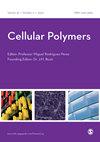Effect of thermal-oxidative and mechanical degradation of recycled LDPE on foaming
IF 1.3
4区 医学
Q4 MATERIALS SCIENCE, BIOMATERIALS
引用次数: 0
Abstract
In this study, we investigated the effect of recycling process on the molecular structure, viscoelasticity and foaming behavior of low density polyethylene (LDPE). A series of LDPE samples with different recycling process was prepared by multiple extrusion using a twin-screw extruder. The molecular weight distribution (MWD) was characterized by gel permeation chromatography (GPC). Wider MWD indicated the generation of higher molecular weight products. Small-amplitude oscillation rheology showed reduced loss factors, indicating that the chain entanglement was more difficult to relax. Moreover, nonlinear viscoelasticity was investigated using elongational rheology and molecular stress function (MSF) model. The results showed a steeper strain hardening exhibited in recycled LDPE. The correlated parameter β in the MSF model indicated that the recycling did not significantly change the branches regularity in LDPE, while the increasing [Formula: see text], the other correlated parameter, indicated that the chain entanglement was enhanced, which was corresponded to the improvement of high molecular weight component. The foaming results revealed that the recycled LDPE had finer cellular structure and higher nucleation density. Moreover, despite adding PP and active CaCO3 to simulate the impurities, the foamability loss of these mixed samples was well restricted and still valuable. Recycled LDPE is instead better than its corresponding virgin one in foaming performance, exhibiting the application potential for further developments.再生低密度聚乙烯的热氧化和机械降解对发泡的影响
本研究探讨了回收工艺对低密度聚乙烯(LDPE)分子结构、粘弹性和发泡行为的影响。通过使用双螺杆挤出机进行多次挤出,制备了一系列采用不同回收工艺的低密度聚乙烯样品。凝胶渗透色谱法(GPC)对分子量分布(MWD)进行了表征。分子量分布越宽,表明生成的产品分子量越高。小振幅振荡流变显示损失因子降低,表明链缠结更难松弛。此外,还使用拉伸流变学和分子应力函数(MSF)模型研究了非线性粘弹性。结果表明,再生低密度聚乙烯表现出更陡峭的应变硬化。MSF 模型中的相关参数 β 表明回收并没有显著改变低密度聚乙烯的分支规则性,而另一个相关参数[公式:见正文]的增加则表明链缠结增强,这与高分子量组分的改善相对应。发泡结果表明,再生低密度聚乙烯具有更精细的细胞结构和更高的成核密度。此外,尽管添加了聚丙烯和活性 CaCO3 来模拟杂质,但这些混合样品的发泡性损失受到了很好的限制,仍然很有价值。再生低密度聚乙烯的发泡性能反而优于相应的原生低密度聚乙烯,显示了进一步开发的应用潜力。
本文章由计算机程序翻译,如有差异,请以英文原文为准。
求助全文
约1分钟内获得全文
求助全文
来源期刊

Cellular Polymers
工程技术-材料科学:生物材料
CiteScore
3.10
自引率
0.00%
发文量
9
审稿时长
3 months
期刊介绍:
Cellular Polymers is concerned primarily with the science of foamed materials, the technology and state of the art for processing and fabricating, the engineering techniques and principles of the machines used to produce them economically, and their applications in varied and wide ranging uses where they are making an increasingly valuable contribution.
Potential problems for the industry are also covered, including fire performance of materials, CFC-replacement technology, recycling and environmental legislation. Reviews of technical and commercial advances in the manufacturing and application technologies are also included.
Cellular Polymers covers these and other related topics and also pays particular attention to the ways in which the science and technology of cellular polymers is being developed throughout the world.
 求助内容:
求助内容: 应助结果提醒方式:
应助结果提醒方式:


